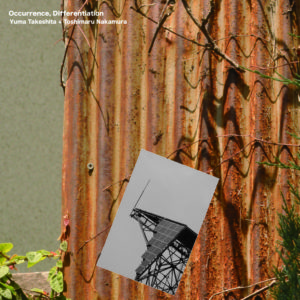
発売日:2017年8月20日(日)
定価:¥2,000(- 税別 )
品番:KYOU-010
Amazon https://amzn.to/2CoYKzH
———————————-
Occurrence, Differentiation
Yuma Takeshita + Toshimaru Nakamura
竹下勇馬 + 中村としまる
1. Occurrence I – 6’29
2. Differentiation I – 10’16
3. Occurrence II – 8’21
4. Differentiation II – 8’01
5. Occurrence III – 11’47
KYOU-010
20.Aug 2017 release
2.000yen+tax
[soundcloud id=’330062878′ width=’1024px’ height=’false’ format=’playlist’]
<作品概要>
今作は東京の即興/実験音楽のCDショップである水道橋Ftarriにて2016年に行われたデュオでのライブパフォーマンスによる録音素材を基にそれぞれがエディット、再構築したもので、演奏、エディットの両面から両者のアプローチの違い、もしくは共通点を見出だすことが出来る。
/////////////////////////////////////////////
<アーティスト>
竹下勇馬
1982年大阪生まれ。
2001年頃から関西のライブハウスを中心に、即興/実験音楽を軸とした演奏を始める。
2011年、東京に拠点を移して以降は演奏活動と平行して独自の発想に基づいた楽器制作も開始。
音響/駆動モジュールを搭載した改造エレクトリック・フレットレスベース”electro-bass”を主に使用し、機構と回路の構築による楽器の身体化を試みている。
過去にリリースされた音源として、2015年に《《》》metsu(大島輝之、中田粥、竹下勇馬、石原雄治)にて「《《》》」(FLOOD/FLD-02)、「Relay」(doubtmusic/dmf-161)、
2016年サラダマイカル富岡製糸場グループ(self-released)、
2017年にはソロアルバム「Mechanization」(Midnight Circles/C-44 from Germany)などがある。
参加グループ:
《《》》metsu / Tumo / zzzt / そばうどん / サラダマイカル富岡製糸場グループ
過去のイベント:
Nuit Blanche Kyoto 2016 (パフォーマンス)
TPAMフリンジ 2017 東京発、即興演奏の新しい波 (パフォーマンス)
Yuma Takeshita
– Bio
Born in Osaka in 1982,
Yuma Takeshita started playing experimental / improvised music around 2001.
After moving to Tokyo in 2011 he began constructing his own instruments by modifying an electronic-bass guitar with different sound modules and machines.
– Release
2015 :metsu – metsu (FLOOD/FLD-02)Relay (doubtmusic/dmf-161)
2016 : Salad Michael Tommy ok a silk mill group (self-released)
2017 : solo Mechanization (Midnight Circles/c-44)
– Bands
(metsu), Tumo, zzzt, soba-udon,
salad michael tommy ok a silk mill group.
– Past Events
Nuit Blanche Kyoto 2016 (performance)
TPAM Fringe 2017 New Waves of Improv in Tokyo (performance)
more information
https://nr-ytmusic.tumblr.com/
/////////////////////////////////////////////
中村としまる
私、中村としまるは、即興演奏を専らとする演奏家であって、自ら名付けた”no-input mixing board” を主に演奏に用いる。市販品の小型オーディオミキサーに、通常の使用法から逸脱する、やや無理な結線を施して、音楽制作においてはしばしば忌避されるであろうフィードバック音を発生せしめ、これをあえて、音楽を成立させると了解を取り合った現場に持ち込む。”no-input mixing board” とは、通常の使用法ではその入力端子に供給されるはずの音声情報が与えられていないミキサーという意味である。この手法の特性上、自らの演奏を完全に制御することは不可能であって、予期せず起こる事象を如何に受け入れていくかが、演奏中の私に与えられた課題である。
Toshimaru Nakamura (no-input mixing board) // Biography
His instrument is the no-input mixing board, which describes a way of using a standard mixing board as an electronic music instrument, producing sound without any external audio input. The use of the mixing board in this manner is not only innovative in the the sounds it can create but, more importantly, in the approach this method of working with the mixer demands. The unpredictability of the instrument requires an attitude of obedience and resignation to the system and the sounds it produces, bringing a high level of indeterminacy and surprise to the music. Nakamura pioneered this approach to the use of the mixing board in the mid-1990’s and has since then appeared on over one hundred audio publications, including nine solo CD’s.
He has performed throughout Europe, North America, Argentina, New Zealand, Australia, Korea, China, Singapore and Malaysia, performing and recording both as a soloist and in collaboration with numerous other musicians.
As an active organizer of concerts in Tokyo, Nakamura has helped many musicians coming to Japan find places to perform, both with himself and with others. From 1998 to 2003 Nakamura and Tetuzi Akiyama ran the concert series Improvisation Series at Bar Aoyama and then later the Meeting at Off Site series of concerts. Both these concert series were crucially important in exposing a new manner to improvised music (referred to as Electro Acoustic Improvisation) to the Japanese public and to foreign musicians visiting Japan, making Tokyo one of the global hotspots for this new approach to music.
More information: http://www.toshimarunakamura.com
Selected Discography
Solo
No Input Mixing Board #8. Oral Records, ORAL 53; The Dim Coast, the dim coast 3, 2013 Maruto. Erstwhile, ErstSolo 002, 2011
Egrets. Samadhisound, sound cd ss017, 2010
Dance Music. Bottrop-Boy, B-BOY 025, 2008 Side Guitar. Improvised Music from Japan, IMJ-513, 2003 Vehicle. cubic music, cubic music 08, 2002 No-input Mixing Board [3]. Alcohol, ALTN1CD, 2003 No-input Mixing Board 2. A Bruit Secret, a bruit secret 02, 2001 No-input Mixing Board. Zero Gravity, ZGV-026, 2000
Collaboration
Tetuzi Akiyama, Jason Kahn, and Toshimaru Nakamura. IHJ/Ftarri. Winds Measure, wm39, 2014.
Klaus Filip/Toshimaru Nakamura/Andrea Neumann/Ivan Palacký. messier objects. Ftarri, meena-999, 2012
Toshimaru Nakamura, and John Butcher. Dusted Machinery. Monotype, mono 041, 2011
Koboku Senjû. Selektiv Hogst. Sofa, SOFA 530, 2010.
Keith Rowe, and Toshimaru Nakamura. ErstLive 008. Erstwhile, erstlive 008, 2009
Tetuzi Akiyama, and Toshimaru Nakamura. Semi-Impressionism. Spekk, KK: 020, 2009
Ami Yoshida, and Toshimaru Nakamura. Soba to Bara. Erstwhile, erstwhile 056, 2009
with David Sylvian. Manafon. SamadhiSound, SS016, 2009
Annette Krebs, and Toshimaru Nakamura. Siyu. SoSeditions, soseditions 804, 2008 Jean-Luc Guionnet, and Toshimaru Nakamura. Map. Potlatch, P108, 2008
Sachiko M, Toshimaru Nakamura, and Otomo Yoshihide. Good Morning Good Night. 2-CD set. Erstwhile, erstwhile 042-2, 2004.
////////////////////////////////////////////
